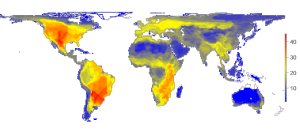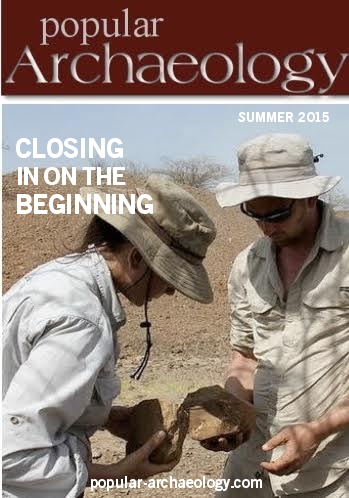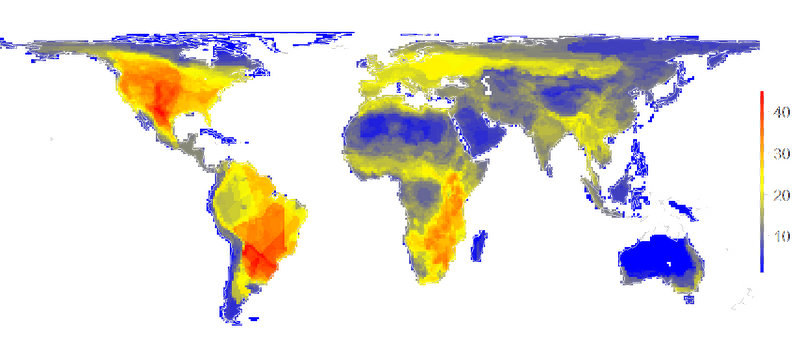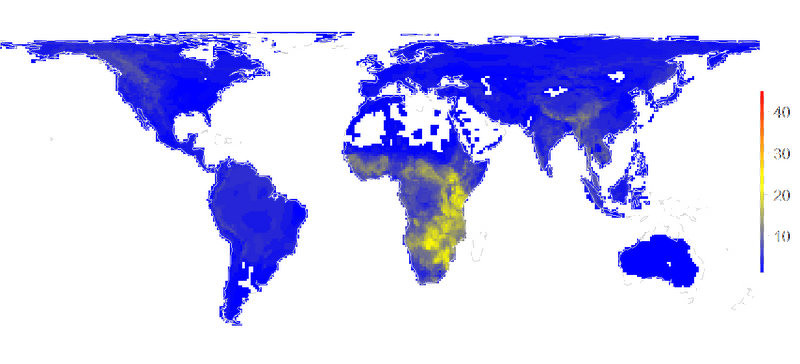
The fact that the greatest diversity of large mammals is found in Africa reflects past human activities – and not climatic or other environmental constraints. This is determined in a new study, which presents what the world map of mammals would look like if modern humans (Homo sapiens) had never existed.
In a world without humans, most of northern Europe would probably now be home to not only wolves, Eurasian elk (moose) and bears, but also animals such as elephants and rhinoceroses.
This is demonstrated in a new study conducted by researchers from Aarhus University, Denmark. In a previous analysis, they have shown that the mass extinction of large mammals during the Last Ice Age and in subsequent millennia (the late-Quaternary megafauna extinction) is largely explainable by the expansion of modern human (Homo sapiens) populations across the world. In this follow-up study, they investigate what the natural worldwide diversity patterns of mammals would be like in the absence of past and present human impacts, based on estimates of the natural distribution of each species according to its ecology, biogeography and the current natural environmental template. They provide the first estimate of how the mammal diversity world map would have appeared without the impact of modern man.
“Northern Europe is far from the only place in which humans have reduced the diversity of mammals – it’s a worldwide phenomenon. And, in most places, there’s a very large deficit in mammal diversity relative to what it would naturally have been”, says Professor Jens-Christian Svenning, Department of Bioscience, Aarhus University, who is one of the researchers behind the study.
Africa is the last refuge
The current world map of mammal diversity shows that Africa is virtually the only place with a high diversity of large mammals. However, the world map constructed by the researchers of the natural diversity of large mammals shows far greater distribution of high large-mammal diversity across most of the world, with particularly high levels in North and South America, areas that are currently relatively poor in large mammals.
“Most safaris today take place in Africa, but under natural circumstances, as many or even more large animals would no doubt have existed in other places, e.g., notably parts of the New World such as Texas and neighboring areas and the region around northern Argentina-Southern Brazil. The reason that many safaris target Africa is not because the continent is naturally abnormally rich in species of mammals. Instead it reflects that it’s one of the only places where human activities have not yet wiped out most of the large animals,” says Postdoctoral Fellow Soren Faurby, Department of Bioscience, Aarhus University, who is the lead author on the study.
The existence of Africa’s many species of mammals is thus not due to an optimal climate and environment, but rather because it is the only place where they have not yet been eradicated by humans. The underlying reason includes evolutionary adaptation of large mammals to humans as well as greater pest pressure on human populations in long-inhabited Africa in the past.
__________________________________________
Above: The natural diversity of large mammals is shown as it would appear without the impact of modern man (Homo sapiens). The figure shows the variation in the number of large mammals (45 kg or larger) that would have occurred per 100 x 100 kilometer grid cell. The numbers on the scale indicate the number of species. Illustration courtesy Soren Faurby
________________________________________________________
Above: The current diversity of large mammals is shown. It can clearly be seen that large numbers of species virtually only occurs in Africa, and that there are generally far fewer species throughout the world than there could have been. Illustration courtesy Soren Faurby.
_________________________________________________________
Better understanding helps nature preservation
The study’s openly accessible data set of natural range maps for all late-Quatenary mammals provides researchers with the first opportunity to analyze the natural patterns in the species diversity and composition of mammals worldwide. Hereby, it can be used to provide a better understanding of the natural factors that determine the biodiversity in a specific area.
Today, there is a particularly large number of mammal species in mountainous areas. This is often interpreted as a consequence of environmental variation, where different species have evolved in deep valleys and high mountains. According to the new study, however, this trend is much weaker when the natural patterns are considered.
“The current high level of biodiversity in mountainous areas is partly due to the fact that the mountains have acted as a refuge for species in relation to hunting and habitat destruction, rather than being a purely natural pattern. An example in Europe is the brown bear, which now virtually only live in mountainous regions because it has been exterminated from the more accessible and most often more densely populated lowland areas,” explains Soren Faurby.
Hereby, this new study can provide an important base-line for nature restoration and conservation.
The study has been published in the scientific journal Diversity and Distributions.
_______________________________________________________
Source: Adapted and edited from a press release of Aarhus University.
_______________________________________________________
 Read more in-depth articles about archaeology with a premium subscription to Popular Archaeology Magazine.
Read more in-depth articles about archaeology with a premium subscription to Popular Archaeology Magazine.
In addition, the latest Popular Archaeology ebook is now available.
______________________________________________
Travel and learn with Far Horizons.
____________________________________________
 This richly illustrated ebook version of a recent Popular Archaeology issue includes the following stories: The discovery of the tomb of a previously unknown pharaoh that is shedding light on a lost ancient Egyptian dynasty; how genetics is revolutionizing what we know about human evolution and our prehistoric past; one scholar’s controversial ‘New Chronology’ and how it supports the historicity of the biblical Exodus; how archaeologists are unearthing new history in Williamsburg, Virginia, a seat of British colonial power in 18th century America; the discovery of the remains of a major Roman legionary base in Israel; the unearthing of an ancient Judean fortified settlement in the borderlands between the biblical kingdoms of ancient Judah and the Philistines; and how archaeologists are uncovering evidence of what may have been an important administrative center of Judah during the 8th century BCE. Now available from Amazon.com!
This richly illustrated ebook version of a recent Popular Archaeology issue includes the following stories: The discovery of the tomb of a previously unknown pharaoh that is shedding light on a lost ancient Egyptian dynasty; how genetics is revolutionizing what we know about human evolution and our prehistoric past; one scholar’s controversial ‘New Chronology’ and how it supports the historicity of the biblical Exodus; how archaeologists are unearthing new history in Williamsburg, Virginia, a seat of British colonial power in 18th century America; the discovery of the remains of a major Roman legionary base in Israel; the unearthing of an ancient Judean fortified settlement in the borderlands between the biblical kingdoms of ancient Judah and the Philistines; and how archaeologists are uncovering evidence of what may have been an important administrative center of Judah during the 8th century BCE. Now available from Amazon.com!
____________________________________________









